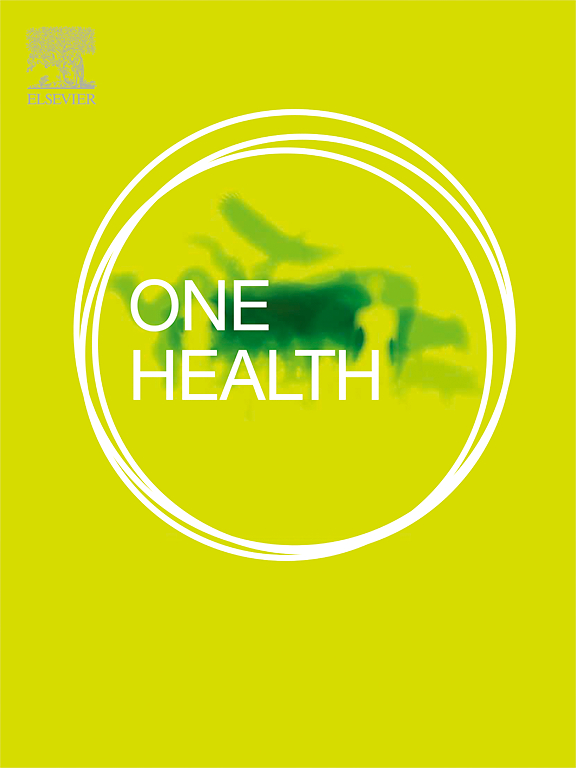美国密西西比州收容犬中土壤传播蠕虫和其他肠道寄生虫的监测。
IF 4.1
2区 医学
Q1 INFECTIOUS DISEASES
引用次数: 0
摘要
近年来,包括圆线虫病在内的土壤传播蠕虫病已成为美利坚合众国东南部的一个突出的公共卫生问题。虽然在密西西比州和阿拉巴马州正在进行人类土壤传播蠕虫(STH)的监测,但很少注意该地区可能从狗身上传播的人畜共患STH。我们使用福尔马林-乙酸乙酯沉淀法对密西西比州252只收容所狗的粪便样本进行了显微镜检查。提取的DNA以犬钩虫、圆线虫、弓形虫和原yonis Baylisascaris为目标进行三次多重实时聚合酶链反应(qPCR)检测。显微镜和qpcr结果显示密西西比犬中STH的总感染率为62.7%,钩虫和弓形虫的感染率分别为50.0%和24.2%。qPCR鉴定出犬钩虫(44.4%)、犬弓形虫(22.2%)、圆线虫(1.2%)和窄头棘虫(0.8%)。qPCR未检出其他犬钩虫、原yonis Baylisascaris、cattoxocara。显微镜下还检出7种肠道寄生虫,分别为狐毛虫(Trichuris vulpis)(13.5%)、Physaloptera sp.(6.4%)、Cystoisospora sp.(3.2%)和犬双胞虫(Dipylidium caninum)(1.2%)。十二指肠贾第鞭毛虫(0.8%)、阿拉尔氏鞭毛虫(0.4%)和大鼻虫(0.4%)。这些发现,结合最近在密西西比州发生的人类病例,突出了有针对性的公共卫生信息的必要性,以促进对狗及其主人的定期驱虫剂治疗。本文章由计算机程序翻译,如有差异,请以英文原文为准。
Surveillance of soil-transmitted helminths and other intestinal parasites in shelter dogs, Mississippi, USA
In recent years, soil-transmitted helminthiases, including strongyloidiasis have become a prominent public health concern in the southeastern United States of America (USA). While there is ongoing human soil-transmitted helminths (STH) surveillance in Mississippi and Alabama, very little attention has been paid to potentially zoonotic STH from dogs in this region. We microscopically examined faecal samples collected from 252 shelter dogs in Mississippi using the formalin-ethyl acetate sedimentation method. Extracted DNA were subjected to three multiplex real-time polymerase chain reaction (qPCR) assays targeting canine STH (canine hookworm species, Strongyloides spp., Toxocara species and Baylisascaris procyonis). The combined prevalence of STH by microscopy and qPCRs in Mississippi dogs was 62.7 %, with hookworms at 50.0 % and Toxocara at 24.2 %. qPCR identified Ancylostoma caninum (44.4 %), Toxocara canis (22.2 %), Strongyloides spp. (1.2 %), and Uncinaria stenocephala (0.8 %). No other canine hookworm species, Baylisascaris procyonis, or Toxocara cati were detected by qPCR. Seven additional intestinal parasites were identified by microscopy, including Trichuris vulpis (13.5 %), Physaloptera sp. (6.4 %), Cystoisospora sp. (3.2 %), Dipylidium caninum (1.2 %). Giardia duodenalis (0.8 %), Alaria sp. (0.4 %), and Macracanthorhynchus sp. (0.4 %). These findings, combined with recent human cases in Mississippi, highlight the need for targeted public health messaging to promote regular anthelmintic treatment for dogs and their owners.
求助全文
通过发布文献求助,成功后即可免费获取论文全文。
去求助
来源期刊

One Health
Medicine-Infectious Diseases
CiteScore
8.10
自引率
4.00%
发文量
95
审稿时长
18 weeks
期刊介绍:
One Health - a Gold Open Access journal.
The mission of One Health is to provide a platform for rapid communication of high quality scientific knowledge on inter- and intra-species pathogen transmission, bringing together leading experts in virology, bacteriology, parasitology, mycology, vectors and vector-borne diseases, tropical health, veterinary sciences, pathology, immunology, food safety, mathematical modelling, epidemiology, public health research and emergency preparedness. As a Gold Open Access journal, a fee is payable on acceptance of the paper. Please see the Guide for Authors for more information.
Submissions to the following categories are welcome:
Virology,
Bacteriology,
Parasitology,
Mycology,
Vectors and vector-borne diseases,
Co-infections and co-morbidities,
Disease spatial surveillance,
Modelling,
Tropical Health,
Discovery,
Ecosystem Health,
Public Health.
 求助内容:
求助内容: 应助结果提醒方式:
应助结果提醒方式:


